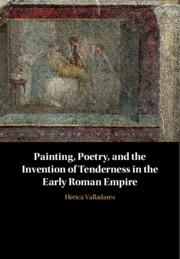Book contents
- Painting, Poetry, and the Invention of Tenderness in the Early Roman Empire
- Painting, Poetry, and the Invention of Tenderness in the Early Roman Empire
- Copyright page
- Dedication
- Contents
- List of Plates
- List of Figures
- List of Tables
- Acknowledgments
- Introduction On Roman Tenderness
- One The Tenderness of Lovers
- Two The Tenderness of Monsters
- Three The Tender Interior
- Epilogue Tenderness Transformed
- Notes
- Bibliography
- Index
One - The Tenderness of Lovers
Published online by Cambridge University Press: 26 November 2020
- Painting, Poetry, and the Invention of Tenderness in the Early Roman Empire
- Painting, Poetry, and the Invention of Tenderness in the Early Roman Empire
- Copyright page
- Dedication
- Contents
- List of Plates
- List of Figures
- List of Tables
- Acknowledgments
- Introduction On Roman Tenderness
- One The Tenderness of Lovers
- Two The Tenderness of Monsters
- Three The Tender Interior
- Epilogue Tenderness Transformed
- Notes
- Bibliography
- Index
Summary
This chapter explores the question of how erotic tenderness was represented pictorially in early Imperial art. The pinakes from cubicula B and D in the Villa della Farnesina in Rome (ca. 20s BCE) are among the earliest surviving tender representations of lovers to have been found in Roman domestic spaces. Since the villa’s discovery in the late nineteenth century, these frescoes have prompted numerous interpretations, mostly of a moralizing, biographical bent. Instead of focusing on the ultimately unanswerable question of who might have owned this splendid residence, the argument presents these well-known wall paintings as expressions of a contemporary cultural phenomenon, namely the formation of a new romantic ideal. Close readings of key passages from Latin love elegy help to situate these images within a larger concomitant debate on privacy and domesticity. This chapter also traces the diffusion of the Roman ideal of amatory tenderness beyond the capital and the court. Two first-century wall paintings from Pompeii, one from the House of Caecilius Jucundus and the other from the House of Lucretius Fronto, demonstrate how quickly this new romantic ideal was absorbed into Roman familial ideology and became emblematic of widespread socio-cultural aspirations.
Keywords
- Type
- Chapter
- Information
- Publisher: Cambridge University PressPrint publication year: 2020

